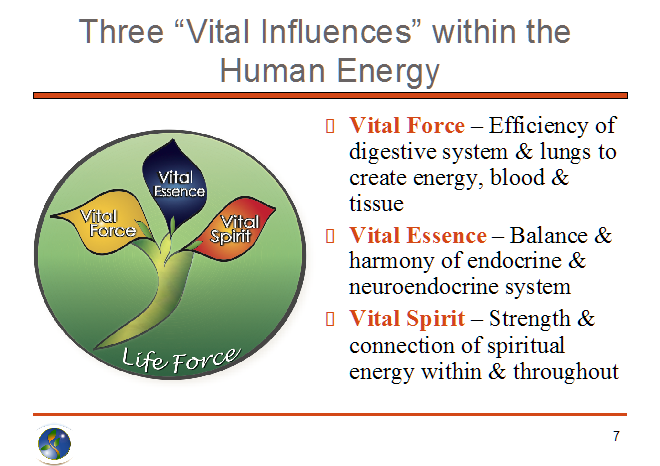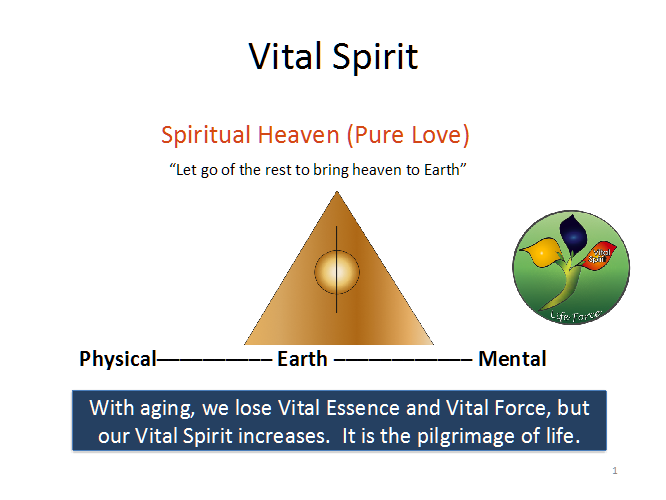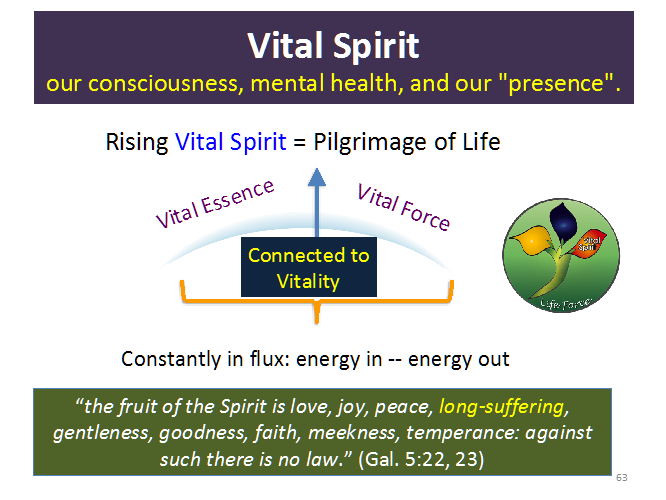In my work, I connect daily with people who have received a diagnosis of cancer or other significant illness. For many, the diagnosis of a life-threatening illness brings life into crystalline focus, making clear what is most important. I believe that a chronic illness, such as cancer, is an invitation to attend to our true nature and to bring our focus into the present moment. This is the essence of the great spiritual teachings of the world, which encourage us to live not in the past or the future, but in the now.
ETMS And Vital Spirit
When assessing the constitutional energetics and physiology of the individual—including physical and psychic dimensions—the Eclectic Triphasic Medical System, or ETMS (often referred to as “Mederi Medicine”) addresses three interrelated vital energetic influences, the Vital Force, Vital Essence, and most importantly, Vital Spirit.
These three vital energetic influences represent different states on a continuum from the physical to the subtle and non-material. Specifically, the Vital Force relates to metabolism, cellular energy transfer, mitochondrial efficiency, and the use of proteins, fats, sugars, and oxygen. It involves the digestive system and lungs, immune system, blood, and bone marrow and emanates primarily through the Digestive-Spleen Organ Network.
The Vital Essence relates to the neuroendocrine (or psychoneuroendocrine) system networked together with entire endocrine and emanates through the Kidney Organ Network. It involves the hypothalamic-pituitary-adrenal endocrine systems and related hormones that contribute to adaptation, growth, reproduction, circadian rhythm, and development, while underlying many aspects of mind and emotion.
The Vital Spirit relates to the spiritual everlasting energy. It emanates primarily through the Heart Organ Network. The Heart Organ Network represents the convergence of heaven and earth energy, linking our consciousness with our unconsciousness. By being connected to the Divine, the heart creates joy and internal vitality. Vital Essence and Vital Force thus both contribute to Vital Spirit, but in clinical practice, each component of this intimately connected triad must always be assessed in terms of its relative contribution to the state of the individual.
The Vital Spirit encompasses the nervous system and is centered in the heart and soul, which through the hypothalamic-pituitary connects the Vital Spirit with all other bodily systems. Reflected in our being as joy, connectedness, optimism, forgiveness, calmness (inner peace), compassion, and love, the Vital Spirit is also responsible for cooling the body, including heat in the form of temperature as well as emotion.
The Vital Spirit corresponds to the way we conduct ourselves in our relationships, and in the world—both how we live, and how we die. The Vital Spirit represents one’s spiritual energy, and is beyond sense, emotion, or thought. In Chinese traditional medicine (TCM) the Vital Spirit is referred to as “Shen”—an immediate way of assessing Shen is to look into the eyes; a “sparkle” is usually an indication of a healthy Vital Spirit.
The Relationship Of Vital Spirit And Cancer
There is now a substantial amount of research demonstrating that perhaps the most effective and overlooked aspect in cancer treatment is the down-regulation of the sympathetic nervous system through a meditation practice known as “mindfulness.”
This new and exciting data from the scientific community suggests that there is a profound interaction between tumors and the psychosocial environment mediated by activation of the adrenaline/ β2-adrenergic receptor (ADRB2).
It turns out that nourishing the Vital Spirit may be the single most important thing you can do to inhibit cancer growth, reoccurrence and metastasis.
Regaining Balance For Wellness
We live in a progressively fragmented world, and this fragmentation negatively affects every aspect of our lives. Even natural medicine is not immune to the tendency to view cancer and other serious illnesses with a narrow focus, addressing only one type of treatment or concentrating on only one aspect of health (for example, diet, exercise, or chemical exposure).
But the body as a whole is interconnected and each cell contains the whole, in the same way that each grain of sand contains the universe. The whole is greater than the sum of the parts, and that is why we need to take a balanced approach to healing the spirit, mind, and body.
It’s important to remember that health cannot be defined merely as the absence of disease. We must expand our view of health to include the entire web of life. We are interconnected with one another, with all living beings, and with all of nature.
Optimal health and wellness includes intellectual, spiritual, emotional, and physical vitality and embraces engaging in attitudes and behaviors that enhance the quality of life. A true state of being “well” is not merely a condition of the individual. Our wellness is interrelated with the wellness of family, community, and environment. Diseases can manifest cellularly, energetically, physically, emotionally, psychologically, and spiritually, and often involve a combination of these causes. Ultimately, to be healthy in the truest sense of the word, you must give love, receive love, and feel a true sense of community. You must live in “harmony”—harmony within, harmony with others, and harmony with nature, or the external environment. Harmony and balance apply to all aspects of living.
A Harmonious Approach To Health
To the Western way of thinking, theology and medicine have little in common. Although some progress has been made in the past several decades in recognizing the interrelationship of the mind, body, and spirit, there is still the tendency to define a human being merely in terms of concrete, physiological attributes. In Eastern Christian ideology, however, just as in Eastern traditional healing systems of medicine, a human being is viewed as a spiritual, psychic, rational, and physical whole.
On the most basic level, we must consider three distinct areas of nourishment that enable us to live and thrive:
- Celestial: Derived from the air that surrounds us, and which we obtain through breathing, which in turn oxygenates all the cells of the body.
- Earthy: The food and water we consume each day, which provides the raw materials to build our physical body (through anabolic processes) and our energy (through catabolic processes).
- Heavenly: Our relationship with God.
To go further, our heavenly nourishment involves three distinct but interrelated relationships:
- Cosmic: Our personal faith in our creator, or our religion. The cosmic relationship is inherently a mystery, and is a relationship of personal faith.
- Nature: The planet and the plant world. In traditional healing modalities, the emphasis is upon Nature (God), and closely follows the principles of Nature as a model for the ideal life.
- Human: Our exchange of love with each other (and animals), giving love, receiving love, and having a sense of belonging. To be whole and healthy, one must be connected to God, nature, self, and others.
The Spiritual Journey
Many people naively view the spiritual journey as a magic carpet ride to bliss. However, this is not a realistic expectation. The spiritual journey involves the purification of the unconscious; it is a humbling process, because it requires letting go of the self that we know and identify with. When we step onto the spiritual path, we are called to change how we respond to life circumstances and how we choose to be in every aspect of our lives.
To live fully, we must reflect on our “being” rather than our “doing.” We must always strive to understand our true nature and allow our doing to become a reflection of our being. We must live being wholly alive in spirit, and it is in this way that we heal on the deepest level of being. All too often, it’s easy to lose oneself in the distractions of daily work and responsibilities, and to disconnect from our true spiritual center. But we are not meant to merely function, we are meant to involve ourselves fully in life by actively living in accordance with what the soul is seeking. The first step is embracing the present moment—which includes facing the unknown.
Living With The Unknown
Fear is a natural and understandable reaction to illness; none of us wants to be sick, and few of us are prepared to deal with the many unknowns that come with the diagnosis of a serious illness.
As humans, we go to great efforts to delude ourselves that we are in control of our lives and our destiny. To this end, we do everything possible to exert control over our environment, ourselves, and other people. Most of us are uncomfortable living with uncertainty, and yet the truth is that by virtue of being alive, we inhabit the unknown—none of us can ever know with certainty what will happen from one moment to the next. If we relinquish the illusion of control, what then? Living in fear is not the answer. Left unexamined, fear tends to expand, reaching its constricting tentacles into more and more aspects of life, until we are left with little but fear.
The answer is to make peace with the state of unknowing. When we learn how to be fully alive in this moment—accepting that we don’t know what the next moment may bring—we free ourselves to live a life that is richer and more fulfilling than any life lived by the strictures of control. Instead of resisting what is and feeding fear, we can instead choose to practice prayer, meditation, and contemplation to encourage present moment awareness, expansiveness, and peace.
Our Doing, A Reflection Of Our Being
Our culture and society emphasize doing instead of being, multitasking is considered a desirable skill, and we are generally more focused on quantity instead of quality in all aspects of our lives. Because our bodies are so efficient at adapting, we are often not aware of the negative impact that this fast pace of life is having on our being, which is in essence our spiritual nature. To live a life of balance, we must understand that life is not a race, and that true happiness never comes from doing more, or having more.
Our life expression of doing, which is manifested in our physical activity, work, and play, reflects our inner being, and thus is an extension of our spirit. We must learn to challenge our learned habits of overdoing and overworking to create a life based on what is most meaningful to us as unique individuals. We must join together the thinking rational mind and our spiritual awareness to have our spiritual being and our expression of doing come into balance.
One important key to staying balanced is to not waste time or energy worrying about things over which we have little or no control. Instead, put your time and energy into focusing on what is in front of you that you can influence for the better, with the intention that your actions may positively benefit others and the world.
Developing and maintaining connection with our inner being requires quiet, peaceful, restorative time. It is only when we allow ourselves this time for self-reflection that we can be certain that we are living in accordance with our deepest truth.
I find that taking time on a daily basis for prayer and reflection is essential for my spiritual, mental, and physical well-being. In my post next week, I’ll share some of my favorite ways of nourishing Vital Spirit.





Hello:
Fourteen years ago I came to you with breast cancer. I followed your treatments and I am still alive.
Thanks